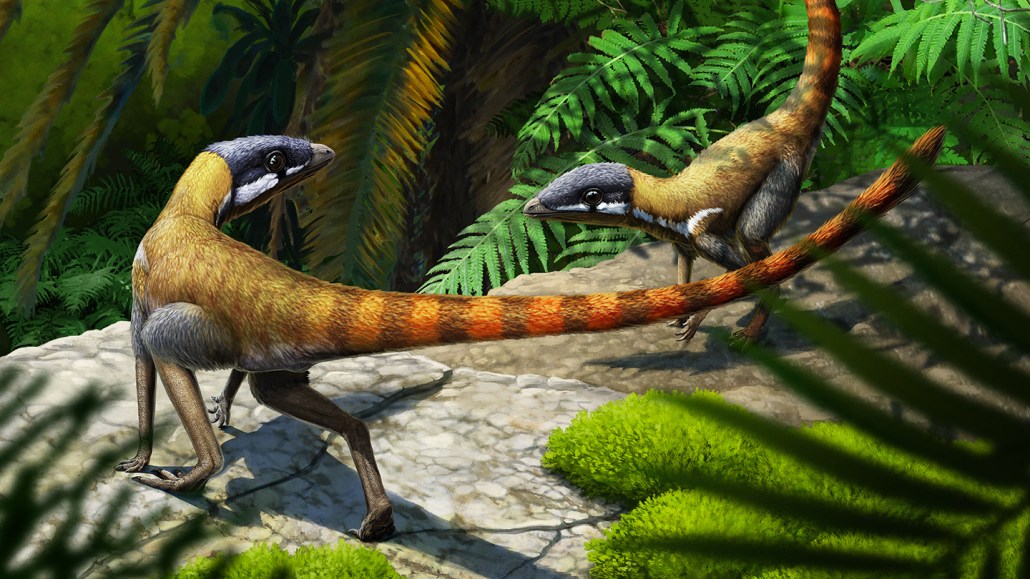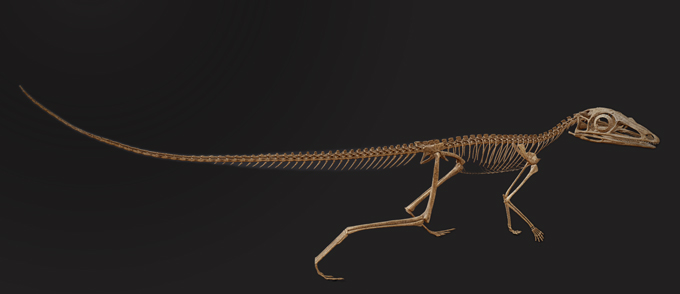Pterosaurs may have evolved from tiny, fast-running reptiles
Fossils found in Scotland in 1907 are illuminating the origin of the first flying vertebrates

Tiny Scleromochlus taylori, shown here in an artist’s rendition, was a bipedal, ground-dwelling reptile, and a close relative of pterosaurs, the iconic winged vertebrates of the Age of Dinosaurs.
Gabriel Ugueto
- More than 2 years ago
Read another version of this article at Science News Explores
A mysterious ground-dwelling reptile unearthed in a Scottish sandstone over 100 years ago turns out to be part of a famous flying family. Tiny Scleromochlus taylori was a close relative of pterosaurs, the winged reptiles that lived alongside the dinosaurs, researchers report online October 5 in Nature.
The finding lends support to the idea that pterosaurs — the first vertebrates to master powered flight — evolved from small, two-legged, speedy ancestors.
The study also offers an answer to a long-standing mystery: What, exactly, was S. taylori? “It all boils down to the preservation of this animal,” says Davide Foffa, a paleontologist at National Museums Scotland in Edinburgh.
S. taylori is known entirely from seven individuals preserved in rocks discovered in 1907, fossils that have been difficult to interpret. For one thing, there aren’t any actual bones, just impressions on the surrounding rock; the bones have long since winnowed away. Numerous studies have described and redescribed the creature based on these fossils. And those analyses have in turn suggested that S. taylori was most closely related to dinosaurs, or to pterosaurs, or even to crocodilian ancestors.
What was clear was that the little reptile, which lived about 230 million years ago, had a set of very odd body proportions, Foffa says. At less than 20 centimeters long, “it would fit on the palm of your hand,” but its head was very large for its body. It also had a short neck and long hind limbs. But that rough outline isn’t enough to identify the creature’s closest relatives; that requires finer details of skull, jaw, body proportions and more.
So Foffa and his colleagues used a noninvasive scanning technology called microcomputed tomography to collect previously inaccessible data from the fossils, from the length of its tail to the size of its foot bones to the shape of its jawline.
Some of the creature’s features — like its giant head — are similar to pterosaurs. Others, like the orientation of its lower jaw, aren’t much like pterosaurs at all, the team found. S. taylori didn’t have any identifiable adaptations for flying, jumping or living in trees, the team says. Instead, it was probably a runner.

One of the most important new insights is about the structure of the creature’s femur. It bore strong similarities to both pterosaurs and a group of small, ground-dwelling reptiles called lagerpetids. In particular, the bottom of the femur bone, where it would connect to the lower leg, bears a structure that is a hallmark of lagerpetids, Foffa says.
Taken together, the new data suggest that the creature was almost certainly a lagerpetid. Though lagerpetids didn’t fly, they and pterosaurs have recently been recognized as being very closely related, part of a group collectively called pterosauromorphs. The common ancestor of pterosauromorphs was likely a small, fast-running reptile.
S. taylori, which has features of both, may be a very early lagerpetid, evolving soon after those two pterosauromorph lineages split. That it turned out to have so many features present in both was “kind of a surprise,” says Martín Ezcurra, a paleontologist at the Argentine Museum of Natural Sciences in Buenos Aires who was not involved in the new study. But based on the reanalysis of the fossils, the conclusion that S. taylori was an early lagerpetid makes a lot of sense, he says.
Pterosaurs first appear in the fossil record about 220 million years ago, and their anatomy is distinct, including massive heads for their body sizes and super-elongated fourth digits which were part of their wings (SN: 10/12/10). S. taylori has the big head, but its hands are still small, Ezcurra notes. “We’re missing several intermediate forms in between that bear features related to active flight,” he says. But this new analysis of old fossils does bring scientists just a little bit closer to the time when pterosaurs’ unique and highly flight-adapted bodies began to evolve (SN: 7/22/21).
It’s difficult to say what such a proto-pterosaur might look like, says Hans Sues, a paleontologist at the Smithsonian Institution in Washington, D.C., who was not involved in the new study. “Scleromochlus is a tiny animal, and it is conceivable that a related small-bodied form climbed around in trees and eventually gave rise to a proto-pterosaur — perhaps through an intermediate gliding stage.”







